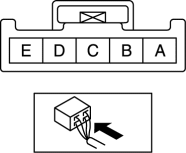Mazda CX-5 Service & Repair Manual: Steering Angle Sensor Inspection
1. Remove the column cover..
2. Connect the plus (+) end of a tester to steering angle sensor terminal A and the minus (-) end of the tester to terminal B (GND).

3. Switch the ignition ON (engine off or on).
4. Turn the steering wheel to the left and right.
5. Verify that the voltage from steering angle sensor terminal A to B (GND) is as indicated in the table.

-
If the voltage can be verified as indicated in the table, go to the next step.
-
If the voltage is not as indicated in the table, replace the clock spring..
6. Switch the ignition to off.
7. Connect the plus (+) end of a tester to steering angle sensor terminal C and the minus (-) end of the tester to terminal B (GND).

8. Switch the ignition ON (engine off or on).
9. Turn the steering wheel to the left and right.
10. Verify that the voltage from steering angle sensor terminal C to B (GND) is as indicated in the table.

-
If the voltage is not as indicated in the table, replace the clock spring..
 Steering Angle Sensor
Steering Angle Sensor
Purpose, Function
The steering angle sensor outputs the steering angle and steering angle reference
point during the period which the EPS control module performs initial learning
(approx. ...
 Turbine/Input Shaft Speed Sensor, Output Shaft Speed Sensor [Fw6 A EL, Fw6 Ax
EL]
Turbine/Input Shaft Speed Sensor, Output Shaft Speed Sensor [Fw6 A EL, Fw6 Ax
EL]
Purpose/Function
The turbine/input shaft speed sensor detects the rotation speed of the input
shaft (low clutch drum).
The output shaft speed sensor detects the rotation speed of the ...
Other materials:
Rear Shock Absorber Removal/Installation
1. Remove in the order indicated in the table.
2. Install in the reverse order of removal.
1
Rear shock absorber upper nut
(See Rear Shock Absorber Upper nut Installation Note.)
2
Rear shock absorber lower bolt
3
...
A/C Compressor
Purpose
The A/C compressor circulates the refrigerant in the refrigerant cycle.
The A/C compressor compresses the gaseous refrigerant atomized by the evaporator,
and by pressurizing the gaseous refrigerant, liquification by the condenser
is facilitated.
Function
The ...
Warm Up Three Way Catalytic Converter (Wu Twc) Inspection
CAUTION:
Perform the following procedures, DTC P0421:00 is indicated only.
1. Connect the M-MDS to the DLC-2.
2. Start the engine and warm it up to normal operating temperature.
3. Turn off the engine.
4. Verify that the engine compression is within the specification..
If ...
